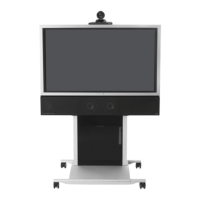
Do you have a question about the TANDBERG 6000 MXP Profile and is the answer not in the manual?
| Maximum Resolution | 1920 x 1080 |
|---|---|
| Frame Rate | 30 fps |
| Network Protocols | H.323, SIP |
| Connectivity | IP, ISDN |
| Power Supply | 100-240V AC, 50/60 Hz |
| Firewall Traversal | Yes |
| Data Rate | Up to 6 Mbps |
| Encryption | AES |
| Video Standards | H.261, H.263, H.264 |
| Audio Standards | G.711, G.722, G.722.1, G.728 |
| Video Resolution | Up to 1080p |
| Audio Output | line out |
| IP Network Features | DHCP, DNS |
| Data Compression Protocol | H.239 |
| Network Interfaces | Ethernet |
| Content Sharing | H.239 |
| Operating Temperature | 0 to 40 °C |
| Audio Input | 2 x Microphone inputs, 1 x Line input |
Guides the user through the process of unpacking the system components and mounting them.
Explains how to connect various cables to the system components for proper operation.
Details the initial configuration settings required for the system after installation.
Explains how to use the remote control for navigating menus and controlling system functions.
Guides users on how to access and navigate the system's on-screen menus.
Provides instructions on how to initiate a video or telephone call using the system.
Details the steps to place a call, including selecting call type and entering the number.
Explains how to set up a conference or add participants to an ongoing call.
Covers how to adjust call quality settings like network, bandwidth, and restriction.
Explains the various methods for controlling the system's camera.
Describes the Presentation functionality for showing external video sources.
Details how to connect and use a PC for presentations via DVI/VGA input.
Explains how diagnostics allow testing of system components and viewing current settings.
Describes how the system performs a self-test to determine internal hardware integrity.
Explains how to check for IP conflicts and initiate a warning if one is detected.
Lists and explains various system warnings, such as network or ISDN issues.
Guides users on how to restart the system and confirm the action.
Covers essential system settings like language, system name, and auto answer.
Explains settings for access codes, incoming calls, and far-end camera control.
Covers settings related to auto layout, local PC display, dual monitors, and picture layout.
Details how to activate optional features like MultiSite and Presenter using option keys.
Explains how to set an administrator password to protect system settings.
Covers settings related to presentation start, H.239, sources, snapshots, PIP, and presentation rate.
Covers settings related to video and audio algorithms, upstream rate, and default call settings.
Explains the system's automatic selection of video algorithms and how to disable them.
Details the automatic selection of audio algorithms and troubleshooting interoperability issues.
Covers settings for motion, sharpness, and intelligent video management.
Explains how IVM configures picture transmission for optimal video quality based on requirements.
Details default call settings for call type, network, bandwidth, and restrict options.
Details the configuration of audio inputs, including microphone and line level inputs.
Explains the configuration of audio outputs, including line level and digital outputs.
Covers echo control and noise reduction settings to improve audio quality.
Details settings for stereo I/O mode, stereo speakers, and output responses.
Explains how Automatic Gain Control (AGC) adjusts audio levels automatically.
Covers video settings, including camera tracking, MCU status, and picture modes.
Covers security settings including encryption, passwords, and camera standby mode.
Explains how the system automatically attempts to establish encrypted calls using AES or DES.
Details the options for selecting the encryption mode (Auto, AES, DES) for calls.
Guides users on managing various system passwords, including administrator and streaming passwords.
Covers network settings, including ISDN, LAN, network profiles, and data ports.
Details how to specify and configure settings for ISDN, external, and leased E1/T1 network types.
Guides users through setting up ISDN-BRI switch types and line numbers.
Explains how to configure PRI switch types, number ranges, and channel hunting.
Covers LAN settings, including IP settings, H.323, SIP, SNMP, IP services, QoS, and 802.1x.
Details IP protocol, IP assignment (DHCP/Static), IP address, subnet mask, and gateway.
Covers H.323 settings, including E.164 alias, H.323 ID, call setup, and prefix.
Details SIP settings for mode, display name, SIP address, and server discovery.
Covers QoS settings like Diffserv and IP Precedence for prioritizing network traffic.
Details the configuration of RS232 serial ports for data transfer and control purposes.
Guides users on how to restore all system settings to their factory defaults.
Provides information on the various video, audio, and network interfaces available on the system.
Details the video inputs and outputs, including supported formats and levels.
Explains the specifications for audio inputs and outputs, including connector types and levels.
Covers the Ethernet and ISDN BRI/PRI network interfaces and their specifications.
Details system security features like access codes, administrator passwords, and encryption.
Explains diagnostic tools for IP, including Q.931 traces, ping, traceroute, and layer 4 ports.
Details the procedures for upgrading system software using web interface, FTP, or ISDN.